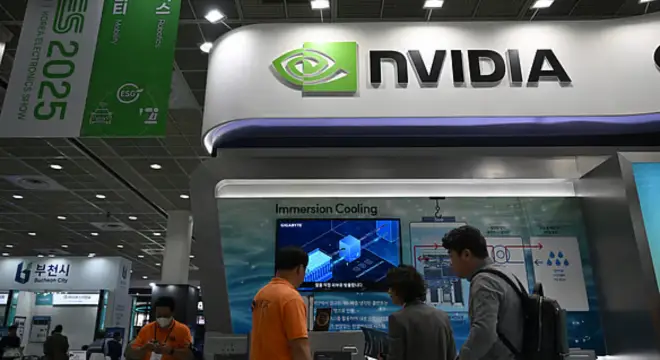You ever get that feeling when something big is happening — something that might change the entire game — but you can’t fully see it yet?
That’s exactly what’s happening right now in South Korea.
Because here’s the headline everyone’s talking about: Nvidia to Supply 260000 AI Chips to South Korea.
Yep — the global tech giant that practically fuels the world’s AI systems has just announced it’s sending a massive 260,000 of its most advanced AI chips to boost South Korea’s growing tech power.
Two hundred and sixty thousand — let that sink in for a second.
But why is everyone talking about it? What’s the big deal? And how did this even begin?
Alright then… let’s take it from the very start.
Scene 1: When Nvidia’s Jensen Huang Met President Lee Jae Myung
It all began at the APEC Summit in Gyeongju, South Korea.
During the summit, Nvidia’s CEO Jensen Huang met President Lee Jae Myung, and the two had a game-changing conversation.
Their goal? To make South Korea the next AI superpower.
And right after that meeting, Nvidia made a huge announcement:
“We’re working with South Korea to expand the nation’s AI infrastructure with over a quarter-million Nvidia GPUs.”
Sounds technical, right? But simply put — Nvidia is about to supercharge South Korea’s AI dream.
Scene 2: Who’s Getting These Chips? Let’s Break It Down
So now the big question — where exactly are all these 260,000 chips going?
Here’s the breakdown:
- Samsung Electronics → 50,000 GPUs for its brand-new “AI Factory.”
Samsung said AI will now be integrated into every part of its production process — from semiconductors to smartphones. - SK Group → another 50,000 chips, to boost smart manufacturing and automation projects.
- Hyundai Motor Group → also getting 50,000 GPUs for AI-driven cars, robotics, and advanced factory systems.
(Self-thinking cars, anyone? ) - NAVER Cloud → South Korea’s top search engine and cloud platform will receive 60,000 chips to scale up its AI infrastructure.
- Government & Cloud Providers → the remaining 50,000 chips will go to national AI centers and public tech initiatives.
So basically — AI is about to run through everything in South Korea, from cars and phones to government systems.
Scene 3: The Viral Dinner Everyone’s Talking About
Now here’s where it gets fun — the night before the announcement, Jensen Huang was spotted having dinner with Samsung’s Jay Y Lee and Hyundai’s Chung Euisun at a local restaurant in Seoul called Kkanbu Chicken.
Yep — three of the most powerful men in Korea, sitting together, eating fried chicken, and probably discussing the future of AI.
Huang even gifted them Nvidia-labelled DGX boxes — powerful AI computers — along with a handwritten note that said,
“To our partnership and the future of the world.”
Tell me that doesn’t sound like a movie scene, right?

Scene 4: Why This Deal Is So Important for South Korea 🇰🇷
Let’s take a step back — why is this deal such a big deal?
Because South Korea isn’t just buying chips; it’s buying power.
For years, Korea has been known for its world-class manufacturing — smartphones, semiconductors, cars.
But now, it’s taking the next leap — from building technology to building intelligence.
With this Nvidia partnership, President Lee Jae Myung’s vision is crystal clear:
“We don’t just want to make tech. We want to lead the intelligence revolution.”
And honestly? He’s right.
Nvidia’s CEO Jensen Huang said it perfectly:
“Korea’s leadership in technology and manufacturing positions it at the heart of the AI industrial revolution.”
Just like electricity and the internet shaped the last century, AI is shaping the next one — and Korea wants to be right at the front of that wave.
Scene 5: The Politics Behind the Deal
Now here’s where the plot thickens.
At the same APEC Summit, Donald Trump and Xi Jinping were also in South Korea, discussing trade, tariffs, and — you guessed it — AI chips.
Because of the U.S.–China trade restrictions, Nvidia’s access to the Chinese market has been limited.
So this partnership with South Korea? It’s a brilliant strategic move.
If China’s market is risky, South Korea is the safe — and smart — alternative.
It’s stable, advanced, and hungry for innovation.
So in a way, this deal isn’t just about technology — it’s about geopolitical power.
Scene 6: What Happens Next?
This deal is just the beginning.
- Hyundai is already working on building a supercomputer for robotics, autonomous driving, and advanced AI development.
- Samsung is integrating AI across its entire production system.
- NAVER and the Korean government are expanding the National AI Computing Center to support future innovation.
In short — Korea is laying the foundation for an AI-powered nation.
From factories to cars to cloud networks, everything is about to get a serious AI upgrade.
Scene 7: So, What Does It All Mean?
When you look at the big picture, this isn’t just a tech deal — it’s a turning point.
One meeting.
One bold decision.
And now, South Korea is on track to become a global AI powerhouse.
Because when a nation gets 260,000 of the world’s most powerful AI chips, it’s not just about improving technology — it’s about shaping the future.
So here’s the real question —
Will South Korea become the next Silicon Valley of Asia?
Or maybe… something even bigger?
Time will tell. But one thing’s for sure —
the AI revolution just found a new home, and it’s glowing bright in Seoul.
Conclusion: The Beginning of a New Era
So, when you really think about it — this isn’t just about Nvidia chips landing in South Korea.
It’s about a nation stepping into its future with confidence.
What started as one meeting between Jensen Huang and President Lee Jae Myung has now turned into a moment that could redefine the global AI map.
South Korea isn’t waiting for the future to arrive — it’s building it, piece by piece, chip by chip.
From Samsung’s AI-driven factories to Hyundai’s self-thinking cars and NAVER’s expanding AI cloud — this isn’t a dream anymore. It’s happening right now.
And maybe, years from now, when we talk about where the world’s next great wave of innovation began —
we won’t just say “Silicon Valley.”
We’ll say “Seoul.”
Because this?
This was the moment South Korea decided not just to join the AI race — but to lead it.


